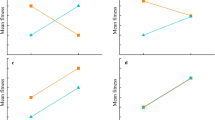Abstract
Embryonic development times and the stage at which embryonic diapause occurs varied dramatically among 23 populations of the Melanoplus sanguinipes/ devastator species complex in California, USA. Grasshoppers were collected from a wide range of latitudes (32°57N to 41°20N) and altitudes (10m to 3031 m), spanning much of the variation in climatic conditions experienced by these insects in California. When reared in a “common garden” in the laboratory, total embryonic development times were positively correlated to the mean annual temperature of the habitat from which the grasshoppers were collected (varying from about 19 days to 32 days when reared at 27°C). These grasshoppers overwinter as diapausing eggs and the proportion of embryonic development completed prior to diapause was significantly higher in populations collected from cool habitats (>70%) than in populations collected from warm environments (<26%). The length of pre-diapause development time is determined by the stage of embryonic development at which diapause occurs, and varies considerably among populations of these grasshoppers; grasshoppers from warmer environments tend to diapause at very early stages of embryogenesis, while grasshoppers from cooler environments diapause at very late stages. The combined effect of variation in embryonic development times and variation in the stage at which diapause occurs results in a dramatic reduction in the time needed to hatch in the spring; populations from warm environments required up to 20 days (at 27°C) to hatch while populations from cool environments required as few as 5 days to complete embryonic development prior to hatching. Egg size also varied significantly among populations, but tended to be larger in populations with shorter embryonic development times. Significant family effects were observed for development time and stage of diapause, suggesting significant heritabilities for these traits, although maternal effects may also contribute to family level variation. We interpret these findings to support the hypothesis that embryonic development time and the stage of embryonic diapause have evolved as adaptations to prevailing season lengths in the study populations.
Similar content being viewed by others

References
Barton NH, Hewitt GM (1989) Adaptation, speciation, and hybrid zones. Nature 341:497–503
Bradshaw WE (1986) Pervasive themes in insect life cycle strategies. In Taylor F, Karban R (eds), The Evolution of Insect Life Cycles, Springer-Berlin Heidelberg, New York, pp 261–275
Coyne JA (1992) Genetics and speciation. Nature 355:511–515
Danks HV (1987) Insect dormancy: an ecological perspective. Biological Survey of Canada, Monograph series No. 1
Dingle H (1986) The evolution of insect life cycle syndromes. In Taylor F, Karban R (eds), The Evolution of Insect Life Cycles, Springer-Berlin Heidelberg, New York, pp 187–203
Dingle H, Mousseau TA, Scott SK (1990) Altitudinal variation in life cycle syndromes of the California grasshopper Melanoplus sanguinipes. Oecologia 84:199–206
EarthInfo (1992) NCDC Summary of the Day on CD-ROM. EarthInfo, Inc. Boulder, CO
Falconer DS (1989) Introduction to Quantitative Genetics, Third Edition. Longman Scientific and Technical, Essex, England
Gibbs A, Mousseau TA, Crowe J (1991) Genetic and acclimatory variation in biophysical properties of insect cuticle lipids. Proc Nat Acad Sci 88:7257–7260
Gilbert F (1990) Insect Life Cycles: Genetics, Evolution and Coordination. Springer-Berlin Heidelberg, London
Grant A, Hassall M, Willott SJ (1993) An alternative theory of grasshopper life cycles. Oikos 66:263–268
Groeters FR, Shaw DD (1992) Association between latitudinal variation for embryonic development time and chromosome structure in the grasshopper Caledia captiva (Orthoptera: Acrididae). Evolution 46:245–257
Gurney AB, Brooks AR (1959) Grasshoppers of the mexicanus group, genus Melanoplus (Orthoptera: Acrididae). Proc US Nat Mus 110:1–93
Lamb RJ, MacKay PA, Gerber GH (1987) Are development and growth of pea aphids, Acyrthosiphon pisum, in North America adapted to local temperatures? Oecologia 72:170–177
Masaki S, Walker TJ (1987) Cricket life cycles. In: Hecht MK, Wallace B, Prance GT (eds), Evolutionary Biology, Vol 21. Plenum Press, NY, USA, pp 349–423
Mayr E (1942) Systematics and the Origin of Species. Columbia Univ Press, New York
Middlekauf WW (1964) Effects of photoperiod upon oogenesis in Melanoplus devastator. J Kan Entomol Soc 37:163–168
Nechols JR, Tauber MJ, Tauber CA (1987) Geographic variability in ecophysiological traits controlling dormancy in Chrosopa oculata (Neuroptera: Chrysopidae). J Ins Physiol 33:627–633
Obrycki JJ, Tauber MJ (1982) Thermal requirements for development of Hippodamia convergens (Coleoptera: Coccinellidae). Ann Entomol Soc Am 75:678–683
Orr MR, Porter AH, Mousseau TA, Dingle H (1993) Molecular and morphological evidence for hybridization between two ecologically distinct grasshoppers (Melanoplus sanguinipes and M. devastator) in California. Heredity (in press)
Richards OW, Waloff N (1954) Studies on the biology and population dynamics of British grasshoppers. Antilocust Bull 17:1–187
Roff DA (1980) Optimizing development time in a seasonal environment: The “ups and downs” of clinal variation. Oecologia 45:202–208
Sibly R, Monk K (1987) A theory of grasshopper life cycles. Oikos 48:186–194
Stroheker HF, Middlekauf WW, Rentz DC (1968) The Grasshoppers of California. Bull Call Insect Survey 10, pp 1–117
Tauber CA, Tauber MJ, Nechols, JR (1987) Thermal requirements for development in Chrysopa oculata: A geographically stable trait. Ecology 68:1479–1487
Tauber MJ, Tauber CA, Masaki S (1986) Seasonal adaptations of insect. Oxford University Press
Templeton AR (1989) The meaning of species and speciation: a genetic perspective. In: Otte D, Endler JA (eds) Speciation and Its Consequences. Sinauer Associates, Sunderland, MA
Wall R, Begon M (1987) Population density, phenotype and reproductive output in the grasshopper Chorthippus brunneus. Ecol Entomol 12:331–339
Author information
Authors and Affiliations
Rights and permissions
About this article
Cite this article
Dingle, H., Mousseau, T.A. Geographic variation in embryonic development time and stage of diapause in a grasshopper. Oecologia 97, 179–185 (1994). https://doi.org/10.1007/BF00323147
Received:
Accepted:
Issue Date:
DOI: https://doi.org/10.1007/BF00323147



